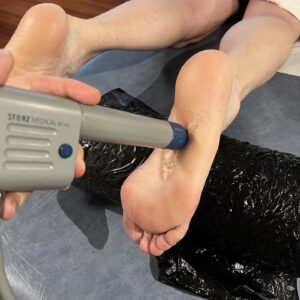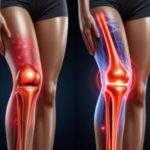Unlock Your Body's Healing Power with Shockwave Therapy: A Safe, Noninvasive Approach
In the evolving realm of modern medicine, Shockwave Therapy, also known as Extracorporeal Shockwave Therapy (ESWT), emerges as a revolutionary treatment that prioritizes safety and noninvasiveness. By employing precisely targeted ultrasonic waves, this cutting-edge technique addresses a variety of musculoskeletal conditions effectively. It is especially beneficial for injuries and ailments related to ligaments and tendons, providing a comprehensive treatment option. Utilizing the unique capabilities of sound waves, Shockwave Therapy not only reduces pain but also speeds up the body’s natural healing mechanisms. As healthcare professionals recognize its efficacy, this holistic method is becoming increasingly favored as a dependable alternative to surgical interventions, granting patients a pathway to recovery that is both safe and effective.
 Delve into the Mechanisms: Understanding How Shockwave Therapy Promotes Healing
Delve into the Mechanisms: Understanding How Shockwave Therapy Promotes Healing
At its core, Shockwave Therapy operates by directing concentrated sound waves toward specific areas of the body affected by injury or dysfunction. This noninvasive approach is designed to stimulate the body’s innate healing processes, resulting in significant improvements in recovery rates. The application of these therapeutic sound waves enhances blood circulation and fosters cellular regeneration, which plays a crucial role in tissue healing. Patients routinely report not only a reduction in pain but also an enhancement in functionality within the impacted areas. This therapy is particularly effective for chronic injuries and conditions, empowering individuals to regain their mobility and overall quality of life, all without the need for surgical interventions.
Discover the Wide-Ranging Benefits of Shockwave Therapy in Rehabilitation
- Accelerate Your Healing Journey with Shockwave Therapy: One of the standout features of Shockwave Therapy is its exceptional capacity to speed up the body’s natural healing processes. By improving blood flow and stimulating cellular regeneration, this therapy not only expedites tissue recovery but also enables patients to quickly return to their everyday activities with minimal downtime.
- Opt for a Safe, Non-Invasive Treatment Alternative: The non-invasive characteristic of Shockwave Therapy distinguishes it as a significant benefit, providing patients with a safer option compared to traditional surgical procedures. This reduces the risks associated with surgery and leads to shorter recovery times, making it an attractive choice for individuals seeking effective treatment.
- Achieve Effective Pain Relief with Targeted Treatment: Shockwave Therapy is widely recognized for its effectiveness in alleviating pain associated with a variety of conditions. This therapeutic approach offers considerable relief without the need for extended medication or invasive procedures, establishing it as a preferred treatment for those suffering from pain.
- Enhance Your Mobility and Functional Capabilities: Post-treatment, many patients notice significant improvements in mobility. By addressing the underlying causes of discomfort, Shockwave Therapy facilitates greater movement and overall comfort, empowering individuals to engage more actively and enjoyably in their daily routines.
- Realize Cost-Effectiveness Compared to Other Treatment Options: In many cases, Shockwave Therapy proves to be a more economical choice compared to long-term medication or surgical alternatives. While healthcare needs and insurance coverage vary, this therapy often represents a financially viable option for patients seeking effective treatment.
- Experience Minimal Side Effects with Shockwave Therapy: While all medical interventions carry some degree of risk, Shockwave Therapy typically results in fewer side effects compared to surgical options or prolonged medication use, further enhancing its appeal as a therapeutic solution.
Key Applications of Shockwave Therapy for Improved Recovery Outcomes
Shockwave Therapy has gained significant recognition for its effectiveness in addressing a broad spectrum of musculoskeletal and soft tissue disorders. Key applications include:
- Relief for Common Foot Conditions: Particularly effective for issues such as Plantar Fasciitis and Heel Spurs, Shockwave Therapy significantly alleviates pain associated with these common foot ailments, facilitating a return to normal activity.
- Valuable Treatment for Tendinopathies: This therapy is beneficial for various tendinopathies, including Achilles Tendonitis, Tennis Elbow, and Jumper’s Knee, aiding in pain reduction and the restoration of function in these critical areas.
- Tackling Knee and Bone-Related Issues: Shockwave Therapy effectively manages Stress Fractures and promotes Delayed Bone Healing, thereby significantly enhancing recovery times for patients dealing with these challenges.
- Alleviation of Calcific Conditions: Particularly for conditions like Calcific Tendonitis and Shoulder Impingement, this therapy offers substantial relief and supports the healing process, improving patient outcomes.
- Management of Chronic Inflammation: Shockwave Therapy is adept at addressing pain associated with chronic inflammatory conditions, guiding patients towards a state of comfort and relief.
- Facilitating Tissue Repair and Healing: This therapy effectively addresses issues like Scar Tissue Degradation and Non-Healing Wounds, promoting healing and regeneration, which is vital for recovery.
Evaluating Shockwave Technologies for Tailored Treatment Plans
- Electrohydraulic Shockwave Therapy (FSWT): Utilizing focused shockwaves, this technique is particularly effective for treating pain, soft tissue injuries, and a variety of musculoskeletal conditions, with expanding applications in Erectile Dysfunction and Regeneration Therapy.
- Linear Low-Intensity Extracorporeal Shockwave Therapy (Li-ESWT): By employing low-energy shockwaves, Li-ESWT fosters healing and tissue regeneration, making it especially beneficial for managing injuries, back pain, and joint discomfort.
- Electromagnetic Shockwave Therapy (FSWT): This advanced technology is utilized for treating serious medical conditions, including cancer therapies, spinal cord injuries, brain tumors, and uterine fibroids, harnessing powerful electromagnetic shockwaves for targeted therapeutic effects.
- Piezoelectric Shockwave Therapy: Specifically designed for the treatment of kidney and gallstones, this method uses high-energy shockwaves to effectively break down stones, offering a noninvasive outpatient solution.
- Radial Shockwave Therapy (RSWT): RSWT provides a non-invasive approach by generating unfocused shockwaves over a broader area, thus stimulating tissue repair and relieving conditions such as tendinitis, bursitis, and plantar fasciitis.
Understanding the Differences Between Radial and Focused Shockwave Treatments
The benefits of both radial and focused shockwave therapies are significant, yet their applications and outcomes can differ considerably. In Radial Shockwave Therapy, shockwaves are distributed over a larger area, making it particularly suitable for treating extensive tissue regions. Conversely, Focused Shockwave Therapy concentrates energy on specific points, allowing for targeted treatment of localized issues. Understanding this distinction is crucial for practitioners when determining the most effective approach tailored to each patient's unique circumstances.
Deciding Between High-Energy and Low-Energy Shockwave Therapies
The choice between high-energy (focused) and low-energy (unfocused) shockwaves in Shockwave Therapy typically depends on the specific condition being treated. High-energy shockwave therapy excels at precisely targeting localized concerns, making it ideal for specific treatment areas. In contrast, low-energy shockwave therapy adopts a broader strategy to enhance overall tissue repair and can offer relief from various musculoskeletal issues and chronic pain syndromes. Recognizing these differences allows practitioners to customize treatments to best meet their patients' individual needs.
How to Locate Professional Shockwave Therapy Services in Your Area
Professional Shockwave Therapy services are widely accessible through specialized medical centers, clinics, and physiotherapy practices. These facilities typically boast state-of-the-art technology and are staffed by trained medical professionals capable of delivering personalized treatments tailored to the unique needs of each patient. By choosing a reputable establishment, patients can ensure they receive high-quality care and effective treatment options, leading to improved health outcomes and a better quality of life.
Shockwave Therapy stands at the forefront of innovation in noninvasive medical treatments. With numerous advantages and applications for conditions affecting the musculoskeletal system, it is reshaping care standards in modern medical practice. The ability of this therapy to promote natural healing, relieve pain, and improve mobility is continuously transforming recovery options for patients seeking relief and enhanced health.
Brought To You By: Shockwave Therapy Preston
Essential Resources on Extracorporeal Shockwave Therapy (ESWT)
American Academy of Orthopaedic Surgeons (AAOS):
Website: https://orthoinfo.aaos.org/
The AAOS offers a wealth of patient education resources and informative articles on various orthopedic treatments, including ESWT.
Mayo Clinic:
Website: https://www.mayoclinic.org/
Mayo Clinic provides comprehensive insights into medical conditions and treatments, including ESWT, in their patient care section.
WebMD:
Website: https://www.webmd.com/
WebMD serves as a valuable health information resource, featuring articles and videos that explain ESWT along with its various applications.
National Institute of Arthritis and Musculoskeletal and Skin Diseases (NIAMS):
Website: https://www.niams.nih.gov/
NIAMS, part of the National Institutes of Health (NIH), offers research-based information on musculoskeletal conditions and treatments, including ESWT.
The post Exploring the Potential of Extracorporeal Shockwave Therapy appeared first on MCR Therapies.
The Article Extracorporeal Shockwave Therapy (ESWT): An Overview appeared first on https://mcrtherapies.com
The Article Extracorporeal Shockwave Therapy (ESWT) Explained Was Found On https://limitsofstrategy.com


I find the topic of Shockwave Therapy particularly intriguing, especially as someone who has experienced musculoskeletal pain firsthand. The idea that a noninvasive approach like ESWT can effectively harness the power of sound waves to stimulate healing really resonates with me. It’s fascinating how this technology reflects a broader trend in healthcare—prioritizing methods that minimize risk and promote natural recovery.
It’s interesting to see how advancements like Shockwave Therapy are changing the landscape of pain management and recovery. I wonder, though, about its long-term effectiveness compared to traditional methods. While the noninvasive nature is certainly appealing, do we have enough longitudinal data on patient outcomes to truly establish its reliability over time?
It’s intriguing to see Shockwave Therapy gaining recognition as a noninvasive treatment option in the landscape of modern medicine. The emphasis on utilizing sound waves to stimulate healing raises several questions about the broader implications of such technology in healthcare. For instance, while many traditional treatments often come with significant risks or recovery times, therapies like this could potentially reduce the burden on healthcare systems by minimizing the need for surgical interventions.
It’s fascinating to see how Shockwave Therapy stands at the intersection of technology and holistic healing. I’ve personally explored various noninvasive treatments for chronic pain and can appreciate the appeal of a method that promotes the body’s intrinsic healing processes.
It’s interesting how technology sometimes feels like it’s pulling that classic magician’s trick—making us believe in the impossible. Shockwave Therapy is like that friend who puts a new spin on an old classic. It’s as if we’re using sci-fi tools to tap into our body’s natural healing powers. Almost makes you feel like a character in a superhero movie, doesn’t it?
It’s great to hear about your journey with noninvasive treatments for chronic pain. The beauty of Shockwave Therapy lies in its ability to harness the body’s own mechanisms for repair; it’s like giving your body a gentle nudge towards healing. Many people are surprised to find how effective a blend of technology and holistic approaches can be in managing pain.
“Absolutely, the blend of modern technology and natural healing is truly remarkable! If you’re interested in exploring more about Shockwave Therapy and its benefits for chronic pain relief, you might find this link helpful.”
https://arquiaca.org/ChocolateHealth
You’ve raised some intriguing points about Shockwave Therapy and its role as a noninvasive treatment modality. While the benefits you highlight—especially the focus on reducing pain and enhancing the body’s natural healing processes—are certainly promising, I can’t help but wonder about the long-term efficacy and widespread acceptance of this therapy.
You’ve touched on a key aspect of the conversation around Shockwave Therapy—its long-term effectiveness and acceptance in the broader medical community. When we look at treatments, we naturally want to see clear, sustained outcomes, especially when it comes to managing pain and aiding recovery.
You bring up a great point about the long-term efficacy and acceptance of Shockwave Therapy. It’s definitely a relatively new player in the field of noninvasive treatments, and the skepticism around newer therapies is entirely understandable.